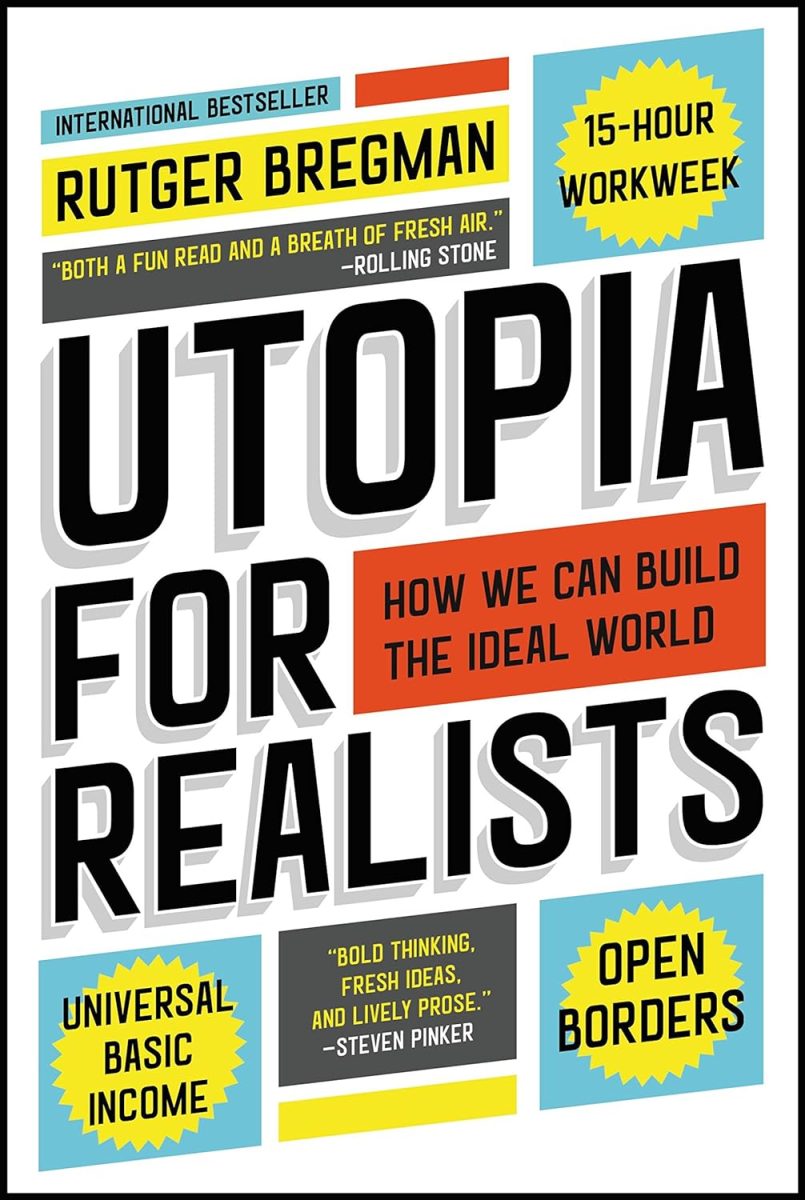In a world stunned by the COVID-19 pandemic, the overwhelming power of artificial intelligence (AI), the ongoing climate crisis, and intractable conflicts, a better future may seem distant. A poll from the Pew Research Center, for instance, shows that in every country surveyed excluding Singapore, the majority of respondents believed that the financial future of the next generation would be worse than the previous generation.
However, there are optimists with simple, yet unconventional ideas to make our world a better place. One of them is Rutger Bregman, a Dutch historian and author of Utopia for Realists: How We Can Build the Ideal World.
We have come a long way
Bregman begins by declaring that for almost all of humankind’s time on earth, we have always been “poor, hungry, dirty, afraid, stupid, sick, and ugly.” He then notes that over the past two hundred years, life for most of humankind has improved exponentially. Modern technologies that were once science fiction are becoming mainstream, fewer people are hungry, and extreme poverty has reduced or has been eradicated in some parts of the world. Despite this progress, our world is not perfect, and Bregman argues that our main challenge is being unable to dream of a better future.
We can even go further and do better
Bregman warns that we should not dismiss utopianism: a belief that we can turn our world into the best place possible. He warns us that to avoid increasing depression, burnout, and mental illnesses, we should not allow our governments to “patch up life” while the markets reign unfettered. At the same time, Bregman acknowledges that utopias have, unfortunately, become dystopias by inciting nationalism and at times, genocide. Nazism, communism, and radical religious sects are examples of hijacked ideas used to oppress people.
Making the world a better place one revolutionary idea after the other
Bregman believes that we could live far more fulfilling lives if governments pursue the revolutionary ideas he proffers. One of the main ideas he emphasizes is the universal basic income (UBI), which he covers in four chapters. He addresses, and dispels, the points of those who, for example, cite the case of Finland, who from 2016-2018 experimented with a nationwide UBI that failed to boost unemployment. Bregman cites several experiments carried out in the United States, Canada, the City of London, Kenya, Uganda, and other countries from the 1960s post the global financial crisis of 2007-2008. They show that not only do UBIs raise people’s wages, but they also reduce malnutrition, truancy and crime (as shown in Namibia), increase the rate of girls and women attending school by 40 percent (as seen in Malawi), and even slightly contribute to a decrease in alcoholism and tobacco use in Africa, Asia and Latin America. Bregman also highlights a five-year experiment in Dauphin, Manitoba, to show that total work hours only decreased by 1 percent for men, 3 percent for married women, and 5 percent for unmarried women. Students studied longer and women with children used it during maternity leave. Men postponed marriage and birth rates declined.
Another idea Bregman proposes is a fifteen-hour workweek. He notes that John Maynard Keynes, one the most influential people in modern economics, envisioned 2030 as the year in which we would work for fifteen hours a week unless politicians made what he considered “disastrous mistakes” (like austerity during a financial crisis.) Maynard Keynes was not the only one who saw this; Benjamin Franklin, Richard Nixon, Karl Marx, and John Stuart Mill all believed that in the future, we would work less. However, the Industrial Revolution brought more work with it. For instance, in factories in Manchester northern England, seventy-hour work weeks were common, even for children. Starting from the 1850s however, workers began to receive more compensation. Although employers resisted strongly, by the end of the century workweeks were less than 60 hours in some countries. Progress continued as Henry Ford, the founder of the revolutionary motor company that bears his surname, ensured his workers had a five-day workweek. Other employers would follow and the National Association of Manufacturers, which was once resistant to shorter workweeks, would happily declare that the United States had the world’s shortest workweeks. Nobel laureate and playwright George Bernard Shaw predicted in 1900 that in 2000, we would have been working for only 2 hours a day. How wrong Shaw was!
Globally, the end of shorter work weeks began in the 1980s. In fact in the United States, workweeks have become longer. Bregman shows that 75 percent of the US working population works over 40 hours a week even though the Fair Labor Standards Act, the law that codifies the 40-hour workweek in the US, has been in place since 1938. Interestingly, Bregman notes that women entering the workforce has squeezed families of their time. Bregman also shows how unfortunately the distinctions between work and leisure are becoming increasingly challenging to identify.
While a fifteen-hour work week may seem like too little work time, Bregman uses strong examples to support them. One example he uses is the one of Edward Heath who was a former British prime minister in the 1970s. On New Year’s Day 1974 amid unprecedented inflation—even the Christmas tree on Trafalgar Square was not lit—he implemented a three-day workweek. The steel industry predicted a 50 percent drop in production. The UK Conservative Party leader predicted a catastrophe. However, the British economy soon recovered and steel production only dropped by 6 percent. Bregman also notes that experts believe that Apple employees might have released the groundbreaking Macintosh computer a year earlier, had they slashed their hours in half. Finally, he proves that shorter workweeks reduce stress, cut emissions, decrease accidents, mitigate unemployment, emancipate women, tackle the problem regarding aging populations and more retirees, and even reduce inequalities.
After brief chapters on the case for dropping gross domestic product (GDP) as the primary economic indicator and higher taxes to “get more people to do work that’s useful,” Bregman delves into the need for completely open borders. Bregman sees them as an alternative to the US$134.8 billion spent on foreign development aid every year, which he believes has not been effective. He notes a World Bank study shows that 85 percent of all foreign development aid was not well utilized. Bregman mentions seven studies that showed that, depending on the level of free movement, global GDP could increase from 67 to 172 percent. The studies Bregman also mentioned that the average Angolan’s income would be US$10,000 and a Nigerian’s would be US$22,000. Developing countries would have US$305 billion to spend if developed countries accepted 3 percent more immigrants. To buttress his argument for completely open borders, Bregman explains how borders and passports were extremely uncommon before World War I. In fact, countries where they were issued such as the Russian and Ottoman Empires were seen as backward. However, in 1920, the world agreed to the use of passports in Paris. Bregman wonders why goods, services, and information are free and open around the world but the movement of people is not. While International Monetary Fund economists predict that if trade barriers were completely removed, the world GDP would grow by no more than US$65 billion. Harvard economist Lant Pritchett estimated that open borders would generate US$65 trillion.
Bregman ends the chapter by deconstructing the fallacies around open borders. He starts by proving that immigrants will not take all the jobs by using the example of when women entered the job market. In the 1970s, women did not take all the jobs away from men as some people predicted; they instead created new ones. Bregman noted a study from the anti-immigration Center for Immigration Studies that shows that immigration has little to no effect on wages. Immigrants are usually not lazy as in some countries, they work even harder than native populations. In Austria, England, Ireland, and Spain, immigrants bring in more tax revenue per capita than the native population. Critics argue that immigrants never go back to their countries of origin and Bregman explains that erecting borders has not encouraged the return of immigrants. In the 1960s for example, before the erection of the border fence between the United States and Mexico, 85 percent of Mexicans returned before or at the expiry of their visas. Nowadays, only 7 percent of illegal Mexican immigrants return.
Generating innovative ideas
Bregman may have started a conversation that we may not be able to ignore for a very long time. At the same time, I am not oblivious to the fact that his ideas will be considered controversial and unrealistic, thus meeting a lot of resistance from different sections of our societies. However, we cannot sit back and watch the world go awry. Our world evidently requires innovative ideas. We all can attest to how the COVID-19 pandemic has changed our work culture across the globe. Hence, we need to constantly refine our thoughts on the way the world works.
As members of the Gen Z generation, we will lead the world while humanity faces some of the most complex challenges. We must be able to try innovative ideas, however absurd they may seem, and engage in meaningful debate. We must dream big while looking at the world realistically. After all some of the ideas, opportunities, or phenomena, that are mainstream today were utopic and ferociously combatted by some a few centuries, years, months, weeks, days, or even hours ago.
_______________
Utopia for Realists: How We Can Build the Ideal World
by Rutger Bregman
Bay Back Books
336 p.























shiding • Mar 6, 2024 at 15:04
very good